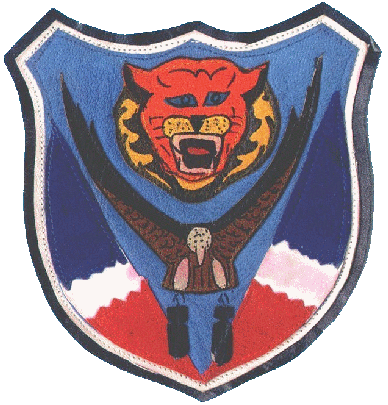Finally, in January of 1944, the Group HQ, with its 22nd and 491st Bomb Squadrons, rejoined with the 11th to assist in maintaining the freedom of valiant China. Leaving the 490th Bomb Squadron behind in India with the principal responsibility for the Burma bridge work, and under control of the Tenth Air Force, the 341st Bomb Group became part of the 69th Composite Wing of the 14th Air Force.
Continuing from the History report, "It is obvious that further orders were issued reassigning to the 10th Air Force. Offices were unpacked advance details were cancelled. The men were disappointed, but no particular adverse effect on morale was noted. Then in January, the Colonel received a radiogram ordering us to China. Most of the men held their tongues in their cheeks, but offices were packed, advance details were ordered out. This time we made it. 7 January the first flight of officers and men from Group Headquarters left for Chabua, India, thence to Kunming, China. The flight was without incident, although on subsequent flights one ship each was lost by the 22nd and 491st Squadrons. As of the time of this writing, there has been no injury or loss of any Group personnel during the movement, and the majority are over the 'Hump.' After the usual sightseeing period in the new country, we received office space and immediately began preparing for operations. On 10 January, the Headquarters officially opened. The morale of all personnel is exceptionally high, due to improved living conditions, excellent food, proximity to large city, and implementation of War Department Policy of replacement of ground personnel."
7 Jan 44, The first flight of officers and men departed India for Kunming, China, and on 10 January the Headquarters is officially opened at Kunming, China.
30 Jan, The Group's first mission in China was flown, with Col Taber leading.
Feb 2 44 - Col Taber duty to sick in hospital. Maj Nickels in command.
On the 19th, movement of all personnel over the 'Hump' to China was completed.
The 14th Air Force was industriously engaged in denying the freedom of the China Seas from the enemy. Operating from their bases high in the rugged mountains of southwestern China, the 341st Group plunged into the task of sinking Japanese shipping along the China coast and in the Tongkin Gulf adjacent to Japanese held French Indo-China.And, when shipping wasn't spotted, Group airmen lashed out against lines of communication and transportation in enemy occupied China and French Indo-China. By the middle of 1944, the Japs were awakened from their lethargy in China by the increasing menace to their sea lane between Singapore, the hub of the western portion of their "Greater East Asia", and Japan proper. Forced to action, the Japanese moved quickly.
In his June 1944 Group History, the historian reports;
Though the destruction rained by the Group in June was again wide spread, the great contribution was the denial to the enemy of the quick victory anticipated by him in the Rice Bowl battle -- Changsha, by the 11th Squadron. The airdromes at Hankow, Wuchang, Pailuchi felt the fury of our attack, troops were hit at Liling, Kweilin, Shishih, and river sweeps along the Siang River south of Changsha netted soldiers and sampans. The sweeps slowed ther ever rising Yellow Tide too. Along with this attack to the Japs in the East, Tenchung, Lungling, Tingka and Yangshih were plastered in the west by the 22nd and 491st Squadrons.
The 341st, increasing the tempo of its activities, threw its weight behind the Chinese forces defending American bases, but despite their gallant efforts the Japanese tide rolled on. Changsha, Hengyang, Kweilin, Liuchow, Nanning all fell in rapid succession.
>By December of 1944 the Japanese had achieved their objective, an overland route from Korea to Singapore. Now they could transport the wealth of natural resources of their southwestern empire via land to their industries in Manchuria and Japan.
The 14th Air Force, assigned the 341st Bomb Group the vital task of interdicting railroad and highway bridges in Indo-China. This new undertaking was tackled with the same enthusiasm which prevailed when the Group moved to China. For this tasking the Group developed a new tactic, derived from the components of 'skip' and 'glide' bombing, which they labeled 'glip bombing'. A tactic which had been successfully employed, and perfected by the "Burma Bridge Busters" of the 490th.of the bridge. The double glide angles of the attack compensated somewhat for this headlong flight into the jaws of the enemy. Nevertheless to successfully 'glip a bridge, a deliberate passage thru the concentration of small arms, machine gun and automatic wapons fire, and sometimes blossoming white puffs of time fused mortar shells was essential. The amount of enemy opposition was not the same at every bridge, but its intensity could be relied upon at the big ones, like Phu Lang Thuong, Hai Duong, Yen Xuang, Phu Ly, Ninh Bibh, Dap Cau, Ba Trung, Song Rang, etc. And, of course, some opposition was likely at every bridge attacked. In addition was the ever present hazard of being caught on the deck by enemy fighters hovering overhead.
But the airmen did not falter. With sustained gallantry they trained against the enemy, they practiced on the enemy, and they became experienced bridge busters at the expense of the enemy's lifeline overland.
